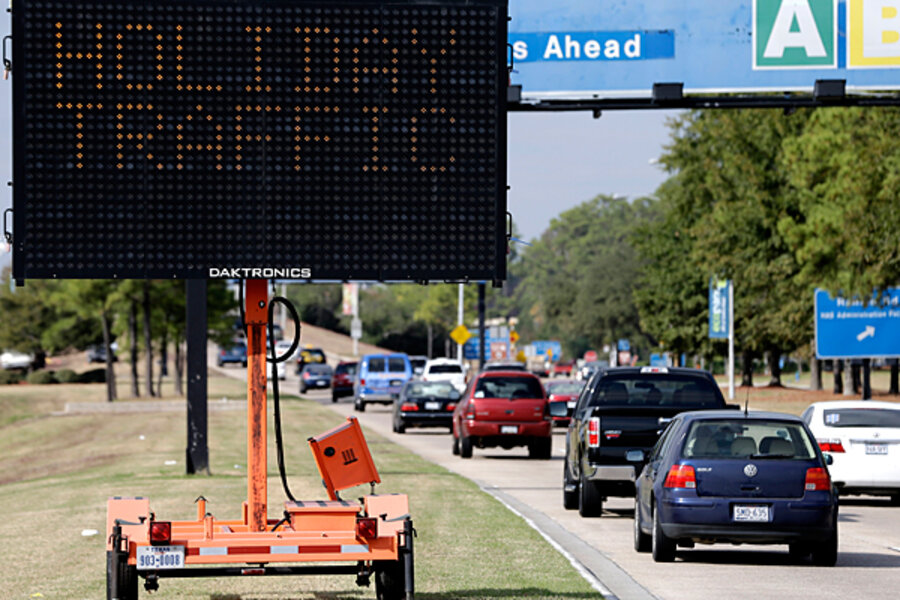US road safety: Deaths lowest in more than 60 years. How we got there.
Loading...
| Los Angeles
Improved technologies and education made America’s roads safer in 2011 than they’d been in more than 60 years, especially for occupants of passenger vehicles, the US Department of Transportation (DOT) reported Monday, and the number of fatalities per vehicle miles traveled was at its lowest level ever.
But DOT’s National Highway Traffic Safety Administration (NHTSA) cautioned that the good news was no reason for American drivers to lower their guard, saying fatalities were still on the rise in some categories, for example for cyclists of all stripes – pedal and motor – and as a result of distracted drivers.
According to NHTSA, traffic fatalities fell to 32,367 in 2011, a 1.9 percent drop over 2010 and the lowest since 1949.
Experts say the reasons for the decline are better seatbelt and airbag technologies, improved driver behaviors on the highways, and more safely designed cars. There has also been more emphasis in recent years on formal official programs to improve safety.
“We’re confident that NHTSA’s 5-Star Safety Ratings Program and nationwide collaborations like ‘Click It or Ticket’ and ‘Drive Sober or Get Pulled Over’ have played a key role in making our roads safer,” said NHTSA Administrator David Strickland.
But they are being careful not to overstate the case. There is still much improvement to be made.
Here are their findings released Monday.
• Fatalities declined by 4.6 percent for occupants of passenger cars and light trucks (including SUVs, minivans and pickups).
• Deaths in crashes involving drunk drivers dropped 2.5 percent in 2011, taking 9,878 lives compared with 10,136 in 2010.
• While Americans drove fewer miles in 2011 than in 2010, the nearly two percent drop in roadway deaths significantly outpaced the corresponding 1.2 percent decrease in vehicle miles traveled. According to updated Fatality Analysis Reporting System (FARS) information released Monday, 2011 saw the lowest fatality rate ever recorded, with 1.10 deaths per 100 million vehicle miles traveled, down from 1.11 deaths per 100 million vehicle miles traveled in 2010.
• Fatalities increased for the occupants of large trucks (20 percent), pedal cyclists (8.7 percent), pedestrians (3.0 percent), and motorcycle riders (2.1 percent). NHTSA said it is working with the Federal Motor Carrier Safety Administration to gather more detailed information on the large truck occupant crashes to better understand the increase in fatalities in 2011.
• The number of people killed in distraction-affected crashes rose to 3,331 in 2011 from 3,267 in 2010, an increase of 1.9 percent. NHTSA believes this increase can be attributed in part to increased awareness and reporting of the phenomenon.
“Even as we celebrate the progress we’ve made in recent years, we must remain focused on addressing the safety issues that are continuing to claim more than 30,000 lives each year,” Mr. Strickland said.
While experts are quick to admonish that citizens should not make too much of the figures and therefore let down their guard – which is the standard cycle for statistics like these – others are being careful to give credit where credit is due.
“The record low fatalities in 2011 are a reflection of the strong progress that's been made in traffic safety,” says Sharon Berlin, a senior research analyst in traffic safety at the American Automobile Association.
“However, our work is far from over,” Ms. Berlin adds. “Motor vehicle crashes remain a public health threat, and we have an obligation to continue investing in making drivers, vehicles, and our roads more safe.”
US Transportation Secretary Ray LaHood expressed similar sentiments, saying seat belt use continues to be an issue.
“The latest numbers show how the tireless work of our safety agencies and partners, coupled with significant advances in technology and continued public education, can really make a difference on our roadways,” he said.
“As we look to the future, it will be more important than ever to build on this progress by continuing to tackle head-on issues like seat belt use, drunk driving, and driver distraction.”







